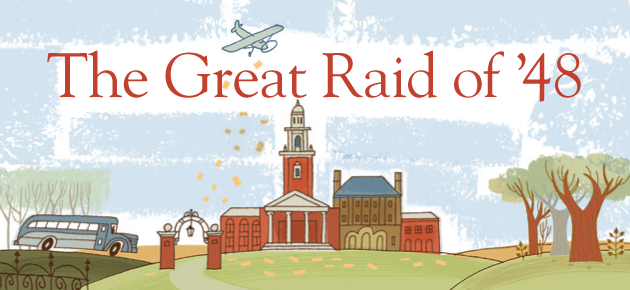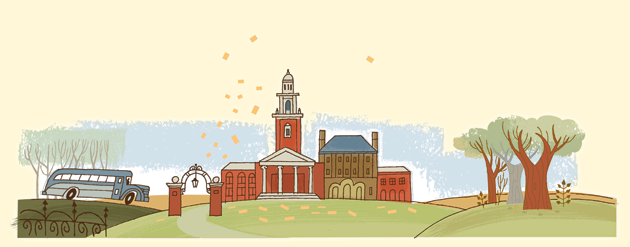
We Bulletin editors are a skeptical lot. When recent letters to the magazine talked about a famous postwar "leaflet drop" over Denison, with Kenyon aviators scattering dance invitations across the rival campus, luring the Denison women away from their insufficiently appreciative male classmates, we had our doubts—and said as much. Was this just another Kenyon legend? A case of memory altered by wishful thinking? A number of graduates set us straight. The leaflet existed. The legend is true, even if the details depend on who's telling the tale. Here's the story of what happened in that bygone era when Kenyon men were a bit lonelier and had airplanes to aid in their schemes. —The Editors

Kenyon freshman Reed Andrews '52 was a man on a mission in the waning autumn of 1948 when he climbed behind the wheel of his green Buick convertible and aimed it toward Denison University. In his rearview mirror he drank in the sweet spectacle of twenty-one trailing cars crammed with Kenyon men eager to follow down the country roads toward Granville.
This was to be the culminating attack of the offensive. Their all-important objective: securing dates for the following night's dance.
Not far away, at the Knox County Airport, a trio of pilots led by Kenyon's Dick Mickelson '51 made a final inspection of their aircraft before setting off on an accompanying bombing run. The planes carried a payload of 3,000 psychological-warfare leaflets, which would cascade like ticker tape upon targeted Denison sororities.
The Great Denison Raid of 1948, an event whose recollection would be colored by apocrypha, mystery, and exaggeration, had begun.
Depending upon the story to which one gives credence, Kenyon student Paul Newman '49 participated in the raid by (a) piloting a Piper Cub that scattered leaflets over Granville, (b) driving a decrepit Chevy that would be destroyed by fire when the muscatel he had substituted for radiator water reached critical mass, or (c) riding shotgun in a Model A Ford beater of which he owned but 50 percent controlling interest.
The correct answer is C, though the question is but one of many surrounding an exploit that over the years has become tangled in the kudzu of collective recall. Were there two, three, or five planes dropping leaflets? Did the raid end in fistfights with offended Denison males, a sorority raid to kidnap prospective dates, or a sing-along among fraternity brothers?
Truth is the subjective property of the teller of the tale.
"Back then we were all men," Reed Andrews recalled. "Five hundred strong. We were looking to do various hell-raising things. I drank a lot of beer with Paul Newman, and we tried to date some of the townies in Gambier, but they were told to stay away from us lecherous Kenyon men."
Five hundred men, alone on an isolated hilltop. It was a cruel, yearning existence.
Even College authorities recognized the plight of Kenyon's monastic males. Ten years earlier, when he arrived as president, Gordon Keith Chalmers had authored the extravagant gesture of recruiting forty blind dates from Rockford College (of which he had previously been president) and busing the coeds—along with their chaperones—418 miles to Gambier.
And now the situation was arguably more dire, or at least more combustible, as many of the Kenyon men were veterans. Mercy missions from Rockford were not their style.
The dating scene entailed a certain amount of competition, according to Bob Brindley '51, who had put up $70 to match Newman's share in the fabled Model A. "He and I double-dated several times," Brindley said, recalling the not-yet movie star.
"One of my dance-weekend dates threw me over and went with him to the next dance weekend. Can you imagine a girl being that dumb?"
Brindley and Newman would join forces in the Great Raid of 1948. Yet the raid might never have occurred if it hadn't been for the arrogance of a few members of the Sigma Alpha Epsilon (SAE) fraternity at Denison. In late November, they decided to declare their independence from the women of their school, and drafted a proclamation.
"Throughout nearly a century of SAE history," the document asserted, "the female sex has had, we feel, too great an influence on our lives. These beasts have all loved us, but they also want to rule our every move. We will tolerate this no longer. The women must go. They must go somewhere where they will be appreciated by weaker men than we. Send them to Kenyon."
The proclamation forbade SAE men from dating Denison women. Indeed, according to the December 10 Collegian, a pair of Denison men who broke the rule "were doused with crankcase oil ... and paraded before the women's dormitories."
The Denison declaration couldn't be clearer. "Deport 'em to Kenyon! Exile 'em."
Women at Denison responded quickly. A group calling themselves "Damsels in Dire Distress" sent out a cry to the north, calling on Kenyon men to come to their rescue.
Accounts differ on exactly how the raid was planned. But the gist is that some Kenyon men, inspired by the Denison damsels' appeal, pooled their money, raising $35 to print the 3,000 leaflets.
The fliers heaped scorn on Denison males. "Step aside, and considerably down, from your false pedestal, long maintained by the wholly unnecessary tolerance of the far superior females. The superior can only be happy with the superior... Kenyon men will now move in and join the fine young women of Denison in a series of mutually sponsored parties consistent with the brand of entertainment mutually superior creatures are accustomed to... The spurned of Denison are hereby invited by the unspurnable Lords of Kenyon to a Lacrosse team dance, Saturday night, December 4th."
Brindley recalls that, as Kenyon men awaited the day of the leaflet drop, he and Newman decided to make an advance visit to Granville. The pre-raid was said to have consisted of eight carloads of Kenyon men.
"We stayed all day," Brindley said, "We had a beer or two with the Denison guys. We were all nice to each other, but the next day, we came back again big-time with the planes."
The Mount Vernon News, alerted in advance of the raid, yet going to press a few hours before the planes left, reported: "Date-hungry Kenyon college students planned to bombard the Denison University campus this afternoon in the newest twist in a revival of the ancient social feud between men of the two colleges... Kenyon, where students are men and women are few, said, in effect, 'Boys, if you don't want them, we do.'"
Doug Downey '51, a participant in the raid, remembered of the embarkation, "At the appointed time, I leaped into a car with six other men, and away we sped. We got a late start and didn't catch up to the caravan until outside of Mount Vernon. When the car rose over the hills, we were able to count them—twenty-two in all, each with at least six passengers."
The Collegian would later report, "The procession waited until the first leaflets had been dropped and then, with horns blowing full blast and pennants waving, the entire group drove up around the campus and came to a halt before the dormitories."
Denison first-year Barbara Cotesworth saw the blizzard of floating paper drifting from the sky. "The pamphlet was just bizarre," she recalls. "The drawing of the woman was just awful, and they were all over the place."
She was likely not the only one offended by the caricature on the leaflet, which depicted a Denison woman wearing a filmy peignoir that plunged at the neck and was split up the side to the hip. The image evoked not so much college girl as downtown Columbus hooker.
Cotesworth was accustomed to a bit more decorum. "We had rules as far as dating," she said. "When dates came to call on you, they called up on the phone to your floor. Some of the people went out and drank and some of them didn't. As a freshman, you date around, but I was only dating Denison freshmen in the beginning."
The ground assault was under way before the last of the leaflets hit the ground. The Collegian reported: "Various groups... dispersed themselves throughout the buildings serenading the occupants and securing dates for Saturday."
Cotesworth noted that the Denison men sprang into action. "I witnessed the Sigma Chi men turning hoses on the cars, of course soaking those in convertibles."
Brindley said of the unfolding action, "Paul and I visited the girls' dorms... and were in the process of persuading some of them to join us for a beer when the chief of police showed up and chased us off."
Doused by dormitory firehoses, and harried by the local authorities, the Kenyon contingent took the parade of cars to downtown Granville. There, curious students and local folk collected to watch the caravan, which somehow became gridlocked by gawkers. If the locals were expecting a show, they weren't disappointed.
"Paul made a speech," Brindley recalls. "He said to me, 'What would you think if we could go around and collect a dollar from everyone here?' He told the crowd, 'If Brindley and I can collect a dollar from every one of you, we'll set the car on fire.' We couldn't collect the first nickel."
Eventually, Andrews and the balance of the accompanying Kenyon cavalry were able to extricate themselves from the traffic jam. Some headed for a Newark bar to congratulate one another on the raid. By dusk, most were on their way back to Kenyon to plot their next move.
With their eye on dates for the next day's dance, the Lords again pooled their money. As the Mount Vernon News would report, "Saturday night, a group of Kenyon students hired a bus, capable of carrying at least 35 to 40 girls and sent it to the campus in Granville Saturday evening.
"But there were no passengers... and the Kenyon sponsors were stuck for the price of the bus." The news story went on to note, however, that twenty Denison coeds attended the dance as individual guests of Kenyon men.
Two of those who best recall the raid—the offended Barbara Cotesworth and the water-drenched Reed Andrews—were destined, two years after the spectacle in Granville, to once again cross paths.
In the fall of 1950, Cotesworth attended a Kenyon dance. Her escort, fearing that she might be stolen away by someone else, actually assigned a pledge to "guard" her while he went to the restroom.
The precautions were in vain. Andrews, who had driven the lead car in the Great Raid, was at the dance that night. He and Cotesworth happened to catch each other's eye.
Reed and Barbara Cotesworth Andrews today are approaching six decades of marriage. A fitting end, worthy of a durable legend.


 Delicious
Delicious Facebook
Facebook StumbleUpon
StumbleUpon Digg
Digg reddit
reddit